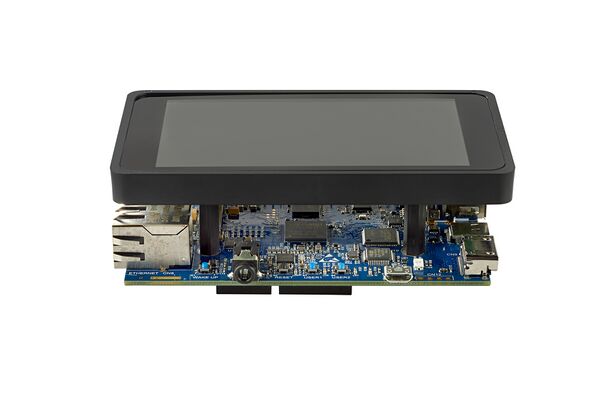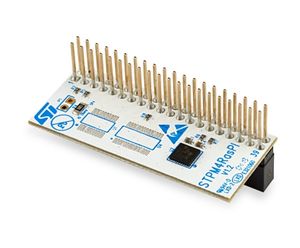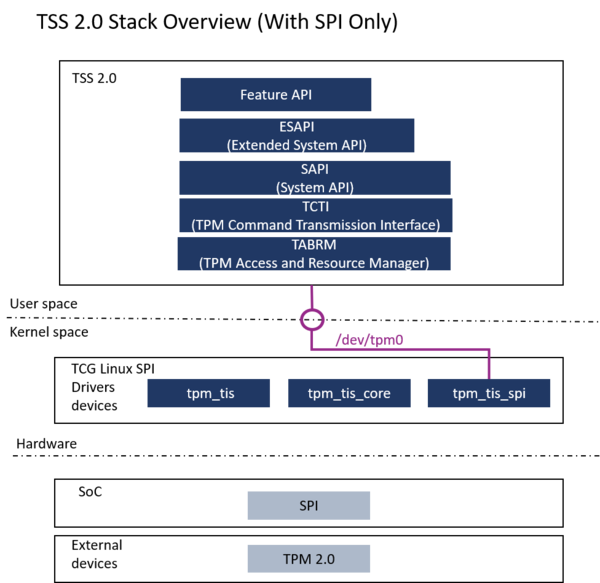1. Article purpose[edit source]
The purpose of this article is to explain how to integrate the STPM4RasPI expansion board with STM32MP157C-DK2, managed by LinuxTM on Cortex®-A7.
A signature verification usecase is included, in order to verify the TPM integration.
Multiple services are available using TPM (mostly on PC and mobile devices):
- Cryptographic keys generation, protection, management and usage
- Cryptographic device identity
- Secure logging, log-reporting and, certification or authentication
- Secure non volatile storage
- Other functions including hashing, random number generation and secure clock
Several use cases are available:
- Platform integrity: the boot process relies on TPM for software integrity and authentication during each boot stage
- Disk encryption: encrypt and decrypt drive using TPM crypto core
- Password protection, and so on.
The usecase described in this article uses the cryptographic key generation functionality on the TPM.
2. Prerequisites[edit source]
2.1. Hardware prerequisites[edit source]
For more information on the STM32 discovery board and how to start it up, go to section Getting started with STM32MP157x-DK2
- STPM4RasPI expansion board[1]
The STPM4RasPI is an official extension board to connect the ST33 TPM products to the Raspberry Pi® device. It is designed for development, proof of concept or demonstration activities. The board is shipped with one soldered trusted platform module. The ST33 TPM device soldered is the ST33TPHF20SPI, and is a TPM V2.0 specification implementation.
2.2. Software prerequisites[edit source]
The STM32MP1 distribution package must be installed on a host PC. The process has been validated with the delivery ecosystem release v2.0.0 . For more information on the OpenSTLinux distribution package go to STM32MP1 Distribution Package article.
For demonstration purposes, the TPM is used at runtime only, on top of the LinuxTM kernel. It uses the TPM2 software stack (TSS) [2] implemented in the OpenSTLinux distribution. The TPM can be handled by the tpm2-tools delivered with the TSS.
To check the TPM features, use the tool openssl (for the signature verification usecase).
3. Software customization to support STPM4RasPI expansion board[edit source]
The LinuxTM kernel must be configured to activate the STPM4RasPI expansion board on the STM32MP157C-DK2 ![]() .
.
The customization consists in modifying the Linux kernel configuration, managing the appropriate device tree elements and including TSS components and openssl tool.
3.1. Kernel configuration[edit source]
The LinuxTM kernel must be updated to include the TPM driver for SPI.
The ST33TPHF20SPI is TCG-compliant and supports the following standard TCG Linux SPI drivers:
(source .../drivers/char/tpm/tpm_tis_spi.c, .../drivers/char/tpm/tpm_tis_core.c, .../drivers/char/tpm/tpm_tis.c).
To check whether associated drivers are enabled inside the kernel, executes the following instructions on the target:
cat /proc/config.gz | gunzip | grep TCG CONFIG_TCG_TPM=y CONFIG_TCG_TIS_CORE=y CONFIG_TCG_TIS_SPI=y
If the above configuration are not enabled, the kernel config has to be modified:
bitbake linux-stm32mp -c menuconfig
Select in the kernel menu config :
Device Drivers ---> Character devices ---> <*> TPM Harware Support ---> <*> TPM Interface Specification 1.3 Interface / TPM 2.0 FIFO Interface - (SPI)
For more information on the LinuxTM Kernel configuration refer to How to configure the Kernel with Menuconfig
3.2. Kernel device tree configuration[edit source]
The TPM driver uses the SPI5 on the GPIO expansion connector.
The device tree must be updated to declare and initialize them.
&pinctrl {
.
.
.
.
/* USER CODE BEGIN pinctrl */
spi5_pins_mx: spi5_mx-0 {
pins {
pinmux = <STM32_PINMUX('F', 8, AF5)>, /* SPI5_MISO */
<STM32_PINMUX('F', 9, AF5)>, /* SPI5_MOSI */
<STM32_PINMUX('F', 7, AF5)>; /* SPI5_SCK */
bias-disable;
drive-push-pull;
slew-rate = <1>;
};
};
spi5_sleep_pins_mx: spi5_sleep_mx-0 {
pins {
pinmux = <STM32_PINMUX('F', 8, ANALOG)>, /* SPI5_MISO */
<STM32_PINMUX('F', 9, ANALOG)>, /* SPI5_MOSI */
<STM32_PINMUX('F', 7, ANALOG)>; /* SPI5_SCK */
};
};
/* USER CODE END pinctrl */
};
&spi5{
pinctrl-names = "default", "sleep";
pinctrl-0 = <&spi5_pins_mx>;
pinctrl-1 = <&spi5_sleep_pins_mx>;
cs-gpios = <&gpiof 6 0>;
status = "okay";
st33htpm0: st33htpm@0{
status="okay";
compatible = "st,st33htpm-spi";
#address-cells = <1>;
#size-cells = <0>;
reg = <0>; /* CS #0 */
spi-max-frequency = <10000000>;
};
};
Information to define a custom device tree is written in How to create your board device tree
3.3. tpm2 TSS components software[edit source]
Add the "tpm2 TSS" component software in the following image file (.../layers/meta-st/meta-st-openstlinux/conf/distro/include/openstlinux.inc)
DISTRO_FEATURES_append = " tpm2 "
3.4. openssl tool[edit source]
Add the "openssl" tool to the image, in the file (.../layers/meta-st/meta-st-openstlinux/recipes-st/images/st-image-weston.bb)
CORE_IMAGE_EXTRA_INSTALL += " \
.
.
.
openssl-bin \
"
3.5. Image build and flash[edit source]
Go the article STM32MP1 Distribution Package for the process to adapt and flash an image for any LinuxTM distributions.
Note that the Software customizations have been applied on a (DISTRO : openstlinux-weston, MACHINE : stm32mp1) OpenSTLinux distribution environment, and for a st-image-weston image.
4. TPM driver loading check[edit source]
When the TPM driver is loaded, /dev/tpm0 and /dev/tpmrm0 are present, as shown in the figure below.
dmesg | grep tpm
[ 1.525447] tpm_tis_spi spi0.0: 2.0 TPM (device-id 0x0, rev-id 78)
ls -l /dev | grep tpm
crw------- 1 tss tss 10, 224 Oct 11 15:27 tpm0
crw------- 1 root root 253, 65536 Oct 11 15:27 tpmrm0
5. Sign data with TPM2 key & signature verification with OpenSSL[edit source]
This is an example of using the TPM to perform signature of a file "msg.txt" hash (digest). A verification is done with the openssl "dgst -verify" command.
Message creation example :
echo dzeydezyetrefygzuedghdgie > msg.txt
Primary key creation :
tpm2_createprimary -C o -c pri.txt
Signature key creation :
tpm2_create -C pri.txt -g sha256 -G rsa -u kpub.bin -r kpriv.bin
Loading of the created signature key in TPM :
tpm2_load -u kpub.bin -r kpriv.bin -C pri.txt -c key.txt
Signature of the hash with the TPM signed key
tpm2_sign -c key.txt -g sha256 -f plain -o hash.plain msg.txt
Read of the public part of the TPM signing key
tpm2_readpublic -c key.txt -f der -o key_sig_pub.der
Verification with openssl dgst
openssl dgst -verify key_sig_pub.der -keyform der -sha256 -signature hash.plain msg.txt
6. References[edit source]


